|
Philadelphia Memories (Part I)
Old Photos Trigger Ancient Recollections: One of my Christmas gifts was a book, 'Lower Northeast Philadelphia'. This captioned photo album brought back a lot of memories. There was an old black & white photo of the S.S. Kresge 5-10-25¢ store on Frankford Avenue, just south of Cottman Ave. When I was a kid, my Mom used to take me there. We walked to 'The Avenue' from our house.
I got a lot of my toys from that Kresge location, including molded plastic cowboys and Indians and 10¢ diecast cars. I still have some of the cars.
The ones shown above were made by Tootsietoys, except for the '53 Studebaker yellow coupe and 1950 GMC orange pickup - those were manufactured by Goodee. (I have repaired and repainted all of them.)
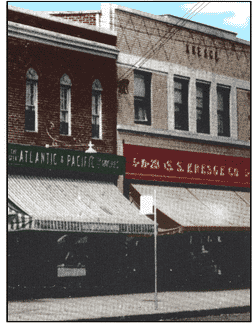 Earlier S.S. Kresge stores carried the traditional 5-10¢ markings on the signage; when the signs were refurbished after World War II, the '25¢' was added. Earlier S.S. Kresge stores carried the traditional 5-10¢ markings on the signage; when the signs were refurbished after World War II, the '25¢' was added.
Next door to the Frankford Ave. Kresge was an old Great Atlantic and Pacific grocery store. As supermarkets took over in the postwar era, these smaller stores disappeared.
A&P Supermarkets were the corporate replacements for Atlantic and Pacific. I remember, as a five year-old, going to the A&P at Frankford and Cottman Avenues in Philadelphia with my mom and strolling down the coffee aisle, inhaling the sweet fumes wafting forth from the big grinder with the chrome-plated knob.
Other small grocery stores in the area included American Stores (which later evolved into Acme Markets) and Unity Frankford Stores.
Unity-Frankfords were individually-owned but were supplied by the Frankford Grocery Company - a wholesaler.
Its warehouse was at Unity and Griscom Streets in the Frankford section of Philadelphia.
The house brands were designated 'Unity' after the warehouse's location. As mentioned in The Frankford Gazette, "There was a time when you could not walk down the street in almost any neighborhood in Philadelphia without seeing a Unity-Frankford Grocery store sign."
There are still a few Unity-Frankford signs still mounted on the building face of small corner stores in Northeast Philly. (posted 1/9/08, permalink)

Tales From The Avenue: My wife found a very interesting booklet among her possessions. It was a giveaway from Third Federal Savings and Loan of Philadelphia (located on Frankford Avenue under the El) where she kept her savings account. The 16-page book, from 1961, is titled 'Main Street - Frankford, A History'. It's all about Frankford Avenue, which was once called the Kings Road or Kings Highway and, later, Main Street. When I was growing up, locals referred to it as The Avenue.
The road originally followed an old Indian trail. It was the first legally laid out county road in the Province of Pennsylvania, being authorized in 1686. Nearly every delegate from New England and New York attending the Continental Congress passed through Frankford on this road. During the British occupation of Philadelphia, Frankford was disputed ground and there were many skirmishes along the road. In 1781, George Washington and his army marched along the road on their way to New York from Yorktown.
In 1824, General Marquis de Lafayette passed through Frankford. To fete him, citizens erected an arch across the road, now called Main Street. There was a platform over the arch on which there were 24 young girls, all dressed in white, representing the number of states in the Union. They sang as the General's procession passed.
In 1854, when Frankford Borough became part of the city of Philadelphia, the street's name changed to Frankford Avenue. In the 1880s, prior to electrification, a steam-powered street car ran on rails along Frankford Avenue. Its terminus was at the 'Old Dummy Depot' at Arrott Street.
The booklet is full of interesting facts - the first public free school in Frankford was started in a log cabin which stood on the corner of Main Street and Brickyard Lane (later renamed Foulkrod Street) in 1821. Growing up, I used to live on Foulkrod Street. (posted 4/4/07, permalink)
"Season's Greetings": For those who think this holiday euphemism is something new, I offer this lucky holiday horseshoe-shaped trinket given to my wife's mom in the 1940s by the folks at Harper's Dress Shop on Frankford Avenue, just south of the Margaret-Orthodox El station in Philadelphia.
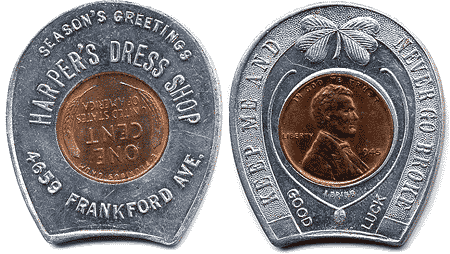
It offers this promise: 'Keep me and never go broke' and features a 1945 copper penny. It apparently works, neither my wife nor her mom have ever gone broke.
The dress shop was not so lucky. Harper's is long gone; the address is now the home of the Leandro Pizza House. (posted 12/17/07, permalink)
No Cheesesteak For You, Señor: An English-only ordering policy has thrust one of Philadelphia's best-known cheesesteak joints, Geno's Steaks, into the national immigration debate.
Situated in a South Philly immigrant neighborhood, Geno's - which together with its chief rival, Pat's King of Steaks, forms the epicenter of an area described as "ground zero for cheesesteaks" - has posted small signs telling customers, "This is America: when ordering 'Speak English'". This is apparently a response to the growing Hispanic population in the area.
By the way, South Philly has always been an immigrant neighborhood. But the ethnicities have changed over time. When my Sherlock ancestors first came to America from County Mayo, Ireland, they lived in South Philadelphia.
In the early 1900s, many Italian immigrants settled in South Philly. In the late '50s-early '60s, you could still hear elderly men and women speaking Italian to one another. I believe that Joey Vento, the 66 year-old proprietor of Geno's, is descended from some of these folks.
As a business owner, Vento can make any lawful customer rules he pleases. But I can't help but wonder if he refuses service to anyone speaking Italian.
The legend is that steak sandwiches and hoagies were invented by Italians. And that only Italians can make them correctly. Although I've never seen either item on any menu during my travels in Italy.
"Which is better, Geno's or Pat's?" is standard debate fodder among Philadelphians. But, when I worked in downtown Philly in the 1970s, I preferred Jim's Steaks on South Street:
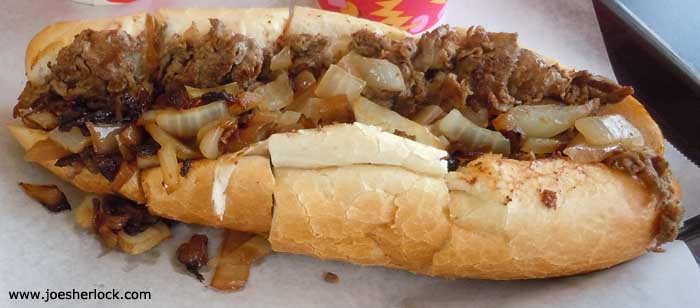
Everyone, from the cook to the cashier, was black. But they sure made a damn fine cheesesteak. And treated all customers ... well, like customers. (posted 6/9/06, permalink)
Book Report: I enjoyed 'The Last Good Time' by Jonathan Van Meter - a book about Skinny D'Amato, his 500 Club and Atlantic City. I learned many things - Atlantic City was founded in 1854 when a rail line was constructed from Camden, New Jersey to Atlantic City.
The first permanent boardwalk was built in 1883; the wicker rolling chairs on the boardwalk were leftovers from the 1876 Philadelphia Centennial Exposition. John Phillips Sousa played for 20 summers on Steeplechase Pier, beginning in 1903. In 1900, Philadelphia had 1 saloon per 1,000 people; New York had 5; Atlantic City had 14.55!! In those days, many Atlantic City bars were open 24 hours per day.
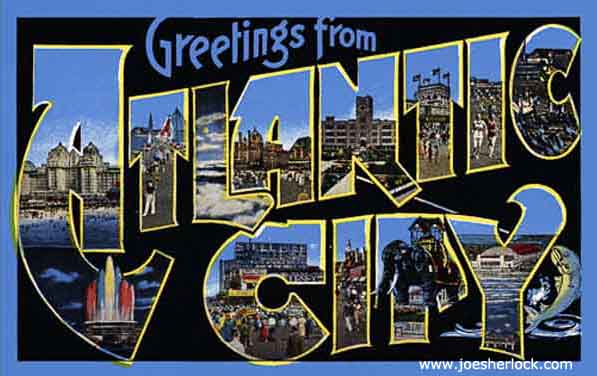
Since - as a teen - I spent many summers in Brigantine (just next door to Atlantic City), the book mentioned places which brought back memories: Chalfont-Hadden Hall Hotel, Knife and Fork Inn and the Million Dollar Pier. There was also a mention of a South Philly Italian restaurant - The Saloon. It's the place where my business buddies threw a farewell luncheon on my last day at Rohm & Haas in 1978. Good food. Strong drinks.
I got a kick out of the names and nicknames in the book ... Stumpy Orman (owner of the Cosmopolitan Hotel), Harry the Hat, Chickie Narducci (the bartender at the 500 Club), BooBoo the Chauffeur, Nucky Johnson (the sheriff of A.C.), Greasy Thumb Guzik, Two Guns Taggart, BooHoo Hoff, etc. They don't make monikers like they used to.
Skinny's daughter, Paulajane, knew all the stars who performed at the 500 Club in the 1950s. She said, "I learned how to play catch with Joe DiMaggio. I learned how to curse from Sophie Tucker and Liberace taught me how to play 'Chopsticks.'" All in all, a great read. If you've ever lived in the Philadelphia or South Jersey area, you'll really appreciate this book. (posted 6/1/04, permalink)
Ode To A Diner: The diner is a uniquely American icon. Diners traces their origins to the early 20th century, when many cities banned oversized horse-drawn "lunch wagons" which were exacerbating urban congestion. Lunch wagon owners quickly turned to a stationary location for their enterprise.
In the early days, decommissioned railroad passenger cars and trolleys were often converted into diners by those who could not afford to purchase a new diner. Many purpose-built diners pay homage to the stainless steel railroad passenger coaches in their exterior styling.
Diners typically offer a broad menu of inexpensive items. During the Depression most diners remained in business because they offered inexpensive places to eat.
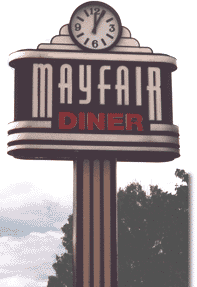 The Mayfair Diner in Northeast Philadelphia is an institution. Founded in 1932, the Mayfair still provides a typewritten 'specials' menu supplement twice a day - one for lunch, one for dinner. (During my visit last October, I even got to meet the typist, Jo, and complimented her on her layout skills.) I enjoyed a great pizza steak at the Mayfair; just as good as the one I ate there 41 years ago. For the first year of my life, I lived less than a half-mile away from this diner, so I guess I have a bond to it. I ate there several times as a kid. My first post-college job was about a mile away, so I sometimes went to the Mayfair for lunch. The Mayfair Diner in Northeast Philadelphia is an institution. Founded in 1932, the Mayfair still provides a typewritten 'specials' menu supplement twice a day - one for lunch, one for dinner. (During my visit last October, I even got to meet the typist, Jo, and complimented her on her layout skills.) I enjoyed a great pizza steak at the Mayfair; just as good as the one I ate there 41 years ago. For the first year of my life, I lived less than a half-mile away from this diner, so I guess I have a bond to it. I ate there several times as a kid. My first post-college job was about a mile away, so I sometimes went to the Mayfair for lunch.
Over the years, many famous people (besides moi) have eaten at the Mayfair. The list includes Presidents Richard Nixon and Bill Clinton, Mayor Frank L. Rizzo, Pennsylvania Gov. Ed Rendell, Flyers superstar Bobby Clarke and local singing legends Bobby Rydell and Fabian.
Two of the Mayfair Diner's greatest appeals were its constant hours - it was open 24-hours, only closing on Christmas Day - and its homemade pies and bread pudding.
In December 2006, the Mayfair Diner was sold. The Mulholland family, which had run it since 1932, handed it over to the Michael Petrogiannis. With close to a dozen diners under his wing, he is Philly's Diner King of the Northeast. "The Golden Greek," one Mayfair patron called him. Petrogiannis said that the diner's menu (a sacred text amongst the Mayfair's many loyal patrons) "would stay mostly the same for the time being."
This is a mild remark underneath which hides the first book of heresy ... Change. "Mostly the same" means change is coming. This is earthshaking - greater than Martin Luther and his Magical Nailgun and Complaint Letter change. Bigger than the Council of Trent change.
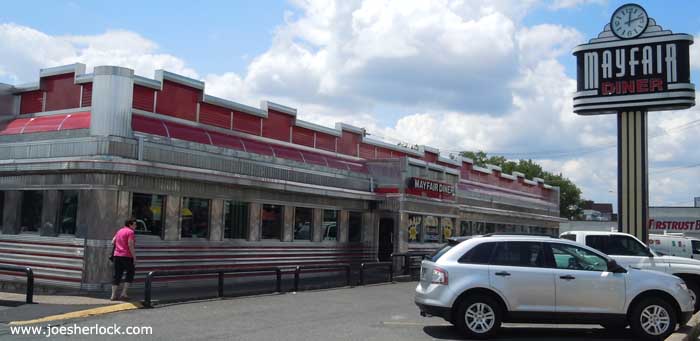
I fear that the Mayfair will not remain the same. And even though - because of the 3,000 mile distance - I only patronize it every five years or so, I mourn the possible loss of its Soul. Nevertheless, I have paid homage to the Mayfair on my O-gauge train layout. Go here to see photos of the 'real' Mayfair Diner and the one on my layout. The diner on my layout is topped with an animated neon sign - it blinks and has a 'buzzy' letter E. The layout features hot rods in the parking lot; the actual parking lot in Northeast Philly is filled with somewhat more ... ummmm ... pedestrian vehicles. (posted 2/7/07, permalink)
PS: A 2011 Mayfair Diner update with more photos can be found here.
2006 Philly Visit: We took a ten-day Fall vacation in the Philadelphia area ... (more >>>)
 Sam's Car: I've been thinking about a custom car I used to see in my Northeast Philadelphia neighborhood when I was 10 years-old or so. Sam's Car: I've been thinking about a custom car I used to see in my Northeast Philadelphia neighborhood when I was 10 years-old or so.
The car was a customized early-'50s red Cadillac convertible and was a rolling advertisement for the owner of Sam's Auto Body.
It had vanity plates (a rare sight in those days): SAMS CAR. The rear of the car was like the GM LeSabre showcar with the center jet pod made from the bullet nose of a '50 Studebaker.
At the time, I thought it was the world's coolest car. I wonder whatever happened to it? (posted 6/10/04, permalink)
Liberty Bell: In Philadelphia, I once saw a one-off, factory-built Volvo 264 limo (in the style of the old Cadillac 75s with a coupe-like window aft of the rear door) parked on Market Street in front of the Liberty Bell. It was bracketed by police cars and was observed during a visit of King Carl Gustaf (of Sweden) to the U.S. The car was an elegant, dark gray with flags on the front fenders.
I guess ol' Carl wanted to see the Bell. Big deal; I used to see it almost every day. I worked right across the street from the ugly Liberty Bell Museum - the one that looked like a car wash. (It has now been replaced with a new, more secure building. It looks like an Applebee's which has been bombproofed.)
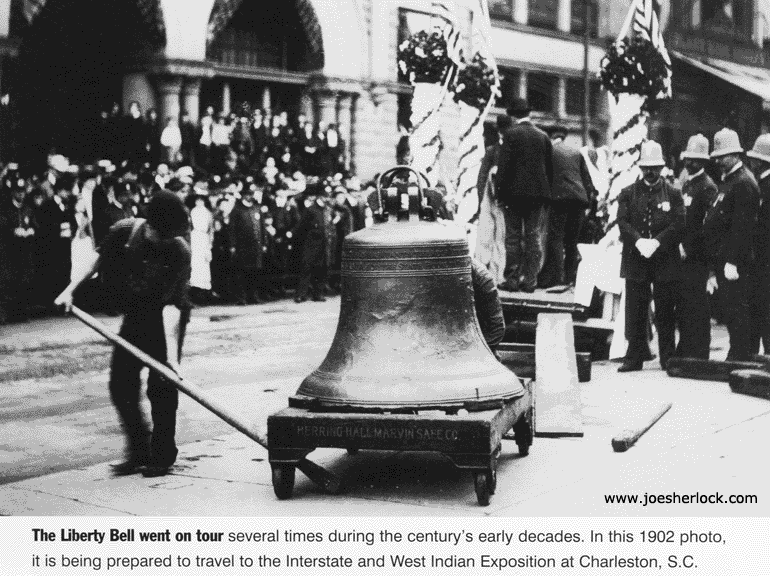
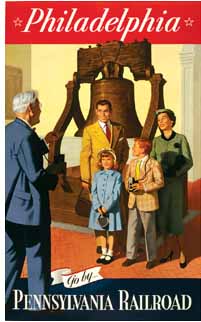 As an eight year-old Cub Scout, I got to bang The Bell with a wooden mallet during a field trip to Independence Hall. They used to keep The Bell under the back stairs. And treated it with disdain. The tour hostess said to us, "It's broken, ya know. And that big crack makes it sound awful." (I know there's a Courtney Love joke in there somewhere but I'll restrain myself.) As an eight year-old Cub Scout, I got to bang The Bell with a wooden mallet during a field trip to Independence Hall. They used to keep The Bell under the back stairs. And treated it with disdain. The tour hostess said to us, "It's broken, ya know. And that big crack makes it sound awful." (I know there's a Courtney Love joke in there somewhere but I'll restrain myself.)
The hostess continued, "Who wants to give it a good whack with this hammer to hear how bad it sounds?" I raised my hand. And the Rest is History. (Trivia: It 'rings' in E-flat.)
Nowadays, of course, you can't even touch the Liberty Bell. Because it's Old. And Historic. Which is quite laughable compared with Europe; they have things that are really Old and Historic. Like ... thousands of years old. And no one seems to care if you touch historical stuff over there. If they don't want you to touch something - like the Magna Carta or a 7th-Century Viking helmet - they display it behind Plexiglas. (Which the British call Perspex.)
So, if you ever need to scratch your backside - and, given the quality of European toilet paper, you may have to do so fairly often - you can simply sidle up to the embellished sarcophagus of some 14th Century monarch and rotate slowly against the carved marble corner to relieve your itch. No one will stop you.
Here's another little tip: In England, most Anglican bishops have their reposing effigies carved on the top of their respective tombs. Dressed in full bishop-gear. You'll find one or more of these in almost every church in England. And those marble pointy hats make excellent ass-scratching posts. Just the right height.
But please don't behave like an Ugly American. If you choose to follow this advice, be sure to mutter, "Mes fesses se sentent meilleures maintenant." That way, people will simply assume you're French. (posted 7/4/04, permalink)
Old Transport Photos: I've been reading: 'Philadelphia Trolleys - Images of Rail.' It is primarily a captioned picture book. What I find most interesting in the photos is not the trolleys, El and subway cars but the scenery and decor around them.
A photo of a 1930s-era newsstand at a subway station reminded me that I used to buy all of my car magazines at such a stand under the Margaret-Orthodox stop on the Frankford Elevated line. It was operated by a thin, polite English fellow who always wore a leather cap. (I don't think I had any car magazine subscriptions until long after I graduated from college.)
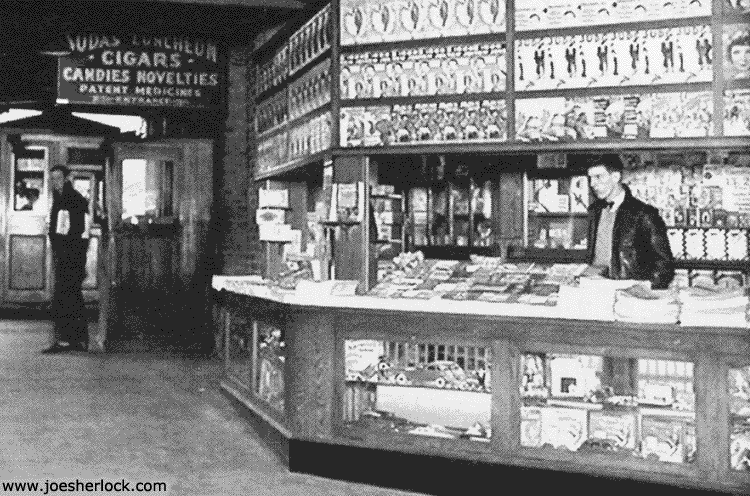
Many of these compact newsstands were far more than just vendors of pulp reading materials - selling cigars, cigarettes, candies, mints, gum, cough drops, aspirin, No-Doz, sunglasses and even gift items like fancy boxed candies and toys. All in less than 100 square feet of space - a remarkable achievement. Even NASA would be jealous.
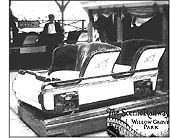 Another photo showed one of the little cars for the Scenic Railway, a wooden roller coaster at the transit company-owned Willow Grove Amusement Park. These four-passenger cars had no seat belts or grab bars; just sit down, clutch the side of the car with your arm and try to hold on. If you stood up or otherwise fooled around and subsequently fell to your death ... tough luck! In those days, amusement parks and playgrounds (and everyday life) offered effective methods for culling the herd of those who lacked common sense. Another photo showed one of the little cars for the Scenic Railway, a wooden roller coaster at the transit company-owned Willow Grove Amusement Park. These four-passenger cars had no seat belts or grab bars; just sit down, clutch the side of the car with your arm and try to hold on. If you stood up or otherwise fooled around and subsequently fell to your death ... tough luck! In those days, amusement parks and playgrounds (and everyday life) offered effective methods for culling the herd of those who lacked common sense.
Because of changes in safety regulations which begun in the 1960s, younger people with no common sense remain alive and are now weaving their gigantic SUVs in the left lane while drinking lattes and chatting on cell phones. (I'm sure you've already encountered some of them.)
I remember riding the Scenic Railway and the two larger roller coasters - The Alps and Thunderbolt - at Willow Grove shortly before it closed in the late 1950s. During its heyday - the early 20th Century, the Park was quite famous. In 1912, John Phillip Sousa conducted band concerts there.
In the same book is a photo of a transit fare booth. As someone who acquired woodworking skills later in life, I now have an appreciation of intricate, detailed wood creations. (Acrylic fabrication was great training for woodworking; many of the same tools and techniques are used for both. In my Plexiglas display manufacturing business, some of my original employees were cabinet makers. They gave me a lot of tips for bringing out the best in wood.)
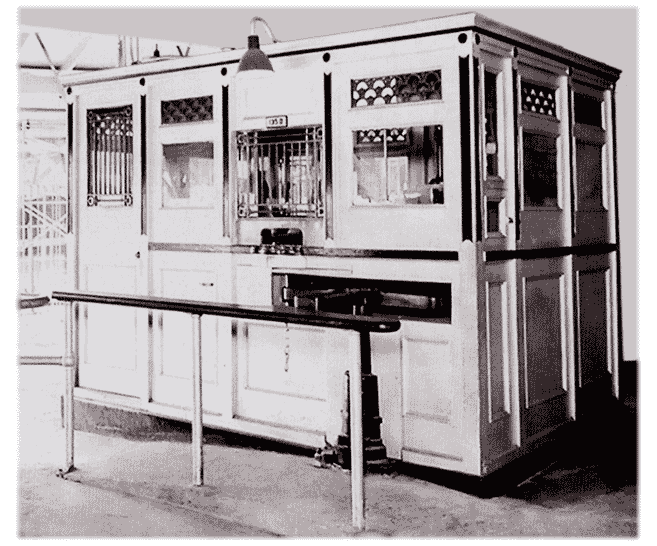
These humble, token-vending, change-making structures were, in their original form, little works of art. The photo, dating from the 1920s or '30s, illustrates fare booth artistry at its peak. By the time that I was a teenager and regular user of the El and subways, the booth's fine details were obscured by countless coats of thick paint, heavy soot, careless repairs and modifications. But, as presented by their original craftsmen, these lowly cubicles are full of interesting embellishments and have a certain boxy, utilitarian elegance. (posted 8/21/04, permalink)
Frank Education: In late 2007, Playboy magazine celebrated its 54th birthday. My introduction to Playboy was at the tender age of 12 at Frank's Barber Shop at Foulkrod and Penn Streets - about two blocks north of the Margaret-Orthodox El station in Philadelphia. Frank also offered issues of Sunshine and Health as reading material. S&H was a nudist magazine; in all the photos, the nekkid people always seemed to be holding beach balls to strategically cover (as the Brits say) "the naughty bits." I have never seen so many beach balls in one place. As a youngster, I figured that nudists must have accounted for 80% of beach ball purchases in the U.S.
Frank's reading material also included True Detective and Confidential - a sleazy, tell-all magazine which made-up most of its salacious stories - featuring blaring, outrageous headlines on the order of: "Perry Como Is Really A Negro!" So many people sued Confidential for slander that it finally went out of business in the late 1950s or early 1960s.
After we moved to New Jersey, I still went to Frank to get my hair cut. Even after we moved to Oregon, I'd stop in for a trim any time I traveled to Philly. Then, on one trip in the early 1980s, I found the shop boarded-up. I inquired at the place next door and found out that Frank had died. Too bad; he was one of the best barbers I've ever known.
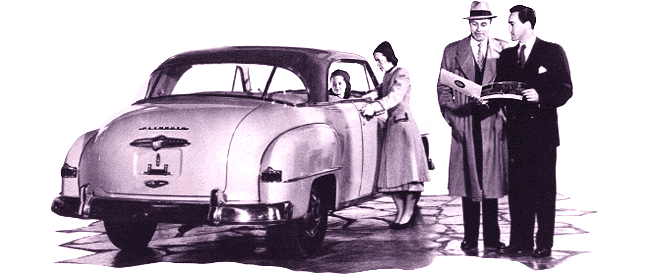
Frank was a car guy and had several 1949-51 Plymouths - the blocky and bland ones. I remember one of them was painted a bilious green color. Why he collected these particular models was never made clear. "I just like 'em," Frank used to tell me. (permalink)
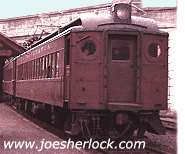 Commuter Memories: Day-hopping to college, I frequently traveled on the Pennsylvania Railroad's Paoli Local. Usually, the train was a consist of ancient MUs - electrically powered, Multiple Unit interurban cars with overhead pantographs and distinctive circular front windows (porthole windows - railroad buffs refer to the them as 'owl eyes'). Commuter Memories: Day-hopping to college, I frequently traveled on the Pennsylvania Railroad's Paoli Local. Usually, the train was a consist of ancient MUs - electrically powered, Multiple Unit interurban cars with overhead pantographs and distinctive circular front windows (porthole windows - railroad buffs refer to the them as 'owl eyes').
When K-Line Trains offered an O-gauge two-car MU set in 2004, I was interested. But I only wanted them if they had the circular windows, so I e-mailed Nick Ladd, K-Line's sales manager. Got a prompt reply: "The PRR version will have the famous "owl" eyes so common on all rust liners. I used to ride them in Philadelphia and loved the look of the round windows."
I ordered the set and was not disappointed. The cars have molded seats with little people in them, proper outside marker lights - red and green - which reverse when the train reverses, directional headlights, train announcements, bell sounds and a realistic digital horn.
I'm glad I got this train set; watching the little MUs running around on my layout brings back lots of memories. More photos can be found here. A description of the Pennsy's MU history can be found here. I have also produced a video short (running time - 1:21 min.) of my MUs in action on my model train layout:
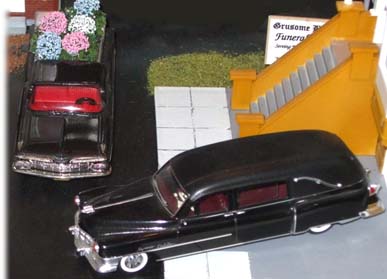 Flower Power: I have a funeral home on my model train layout and, while I have a Cadillac hearse parked in front, I wanted to add a flower car. So, I wasted another portion of my life scratchbuilding a flower car insert for a 1:43 model 1959 Chevy El Camino (a metallic charcoal one from Brooklin Models). I used scale flowers from hobby supply outlet. Flower Power: I have a funeral home on my model train layout and, while I have a Cadillac hearse parked in front, I wanted to add a flower car. So, I wasted another portion of my life scratchbuilding a flower car insert for a 1:43 model 1959 Chevy El Camino (a metallic charcoal one from Brooklin Models). I used scale flowers from hobby supply outlet.
The rack itself is made from card stock which has been cut, glued with epoxy, sanded and painted with several coats of matte silver to imitate the appearance brushed stainless steel. My El Camino conversion has a basis in reality, though.
While most flower cars were Cadillacs and were offered fully finished by hearse manufacturers, conversion kits were available to the trade. A Northeast Philadelphia establishment, Fluehr Funeral Home, had a black 1960 Chevrolet El Camino flower car. One of the undertaker's sons was a car enthusiast and persuaded his dad to purchase an black El Camino pickup and convert it. It had a 348 cubic-inch engine, four-speed transmission and plugged, chrome lakes pipes along the sides. On weekends, the son used to take it to a drag strip, unplug the pipes and race it.
The car was heavily muffled but it was quite amusing to observe a funeral procession in waiting - with the flower car, hearse and limousines lined up outside Fluehr's stately 1930s edifice on Cottman Avenue. All vehicles idled silently with light smoke wisping from the exhausts. But the El Camino, while very quiet, would have a subtle side-to-side shake/quiver - that vehicular epileptic fit characteristic of a V-8 with a 3/4 race cam.
Fluehr's is still in existence at the original location, although there are now at least five other Fluehr Funeral Homes around the Philadelphia area, operated by descendants. I wonder which one is run by the drag racer? (permalink)
| NEXT PAGE |
Other Pages Of Interest
copyright 2004-21 - Joseph M. Sherlock - All applicable rights reserved
Disclaimer
The facts presented on this website are based on my best guesses and my substantially faulty geezer memory. The opinions expressed herein are strictly those of the author and are protected by the U.S. Constitution. Probably.
Spelling, punctuation and syntax errors are cheerfully repaired when I find them; grudgingly fixed when you do.
If I have slandered any brands of automobiles, either expressly or inadvertently, they're most likely crap cars and deserve it. Automobile manufacturers should be aware that they always have the option of trying to change my mind by providing me with vehicles to test drive.
If I have slandered any people or corporations, either expressly or inadvertently, they should buy me strong drinks (and an expensive meal) and try to prove to me that they're not the jerks I've portrayed them to be. If you're buying, I'm willing to listen.
Don't be shy - try a bribe. It might help.
|

